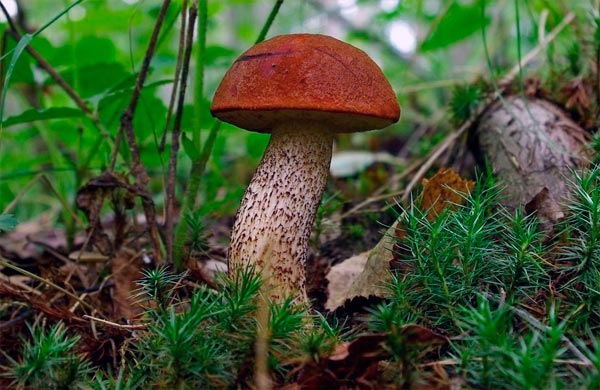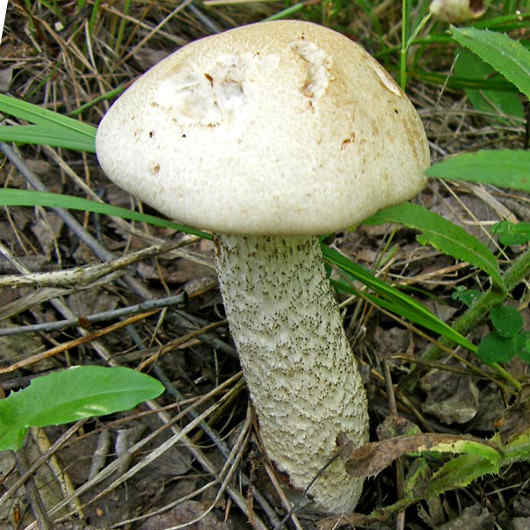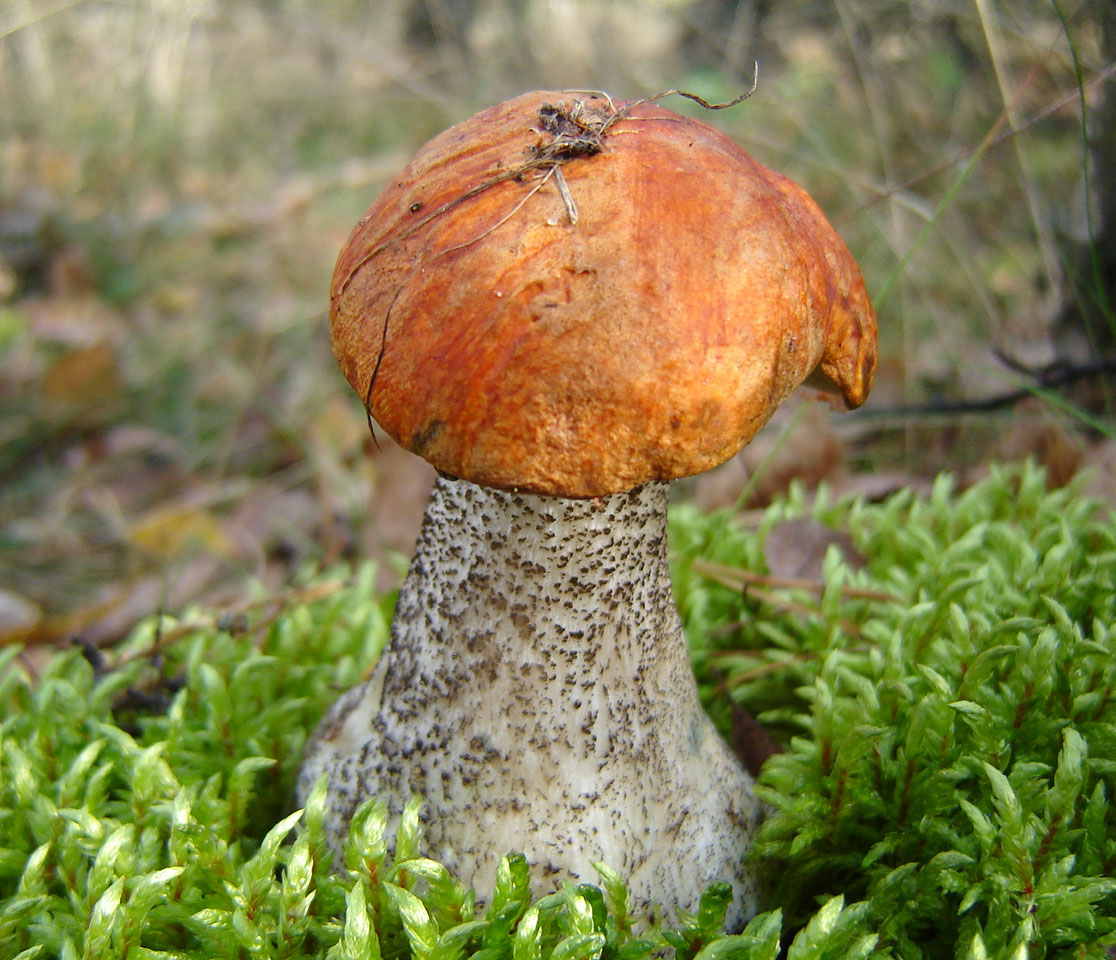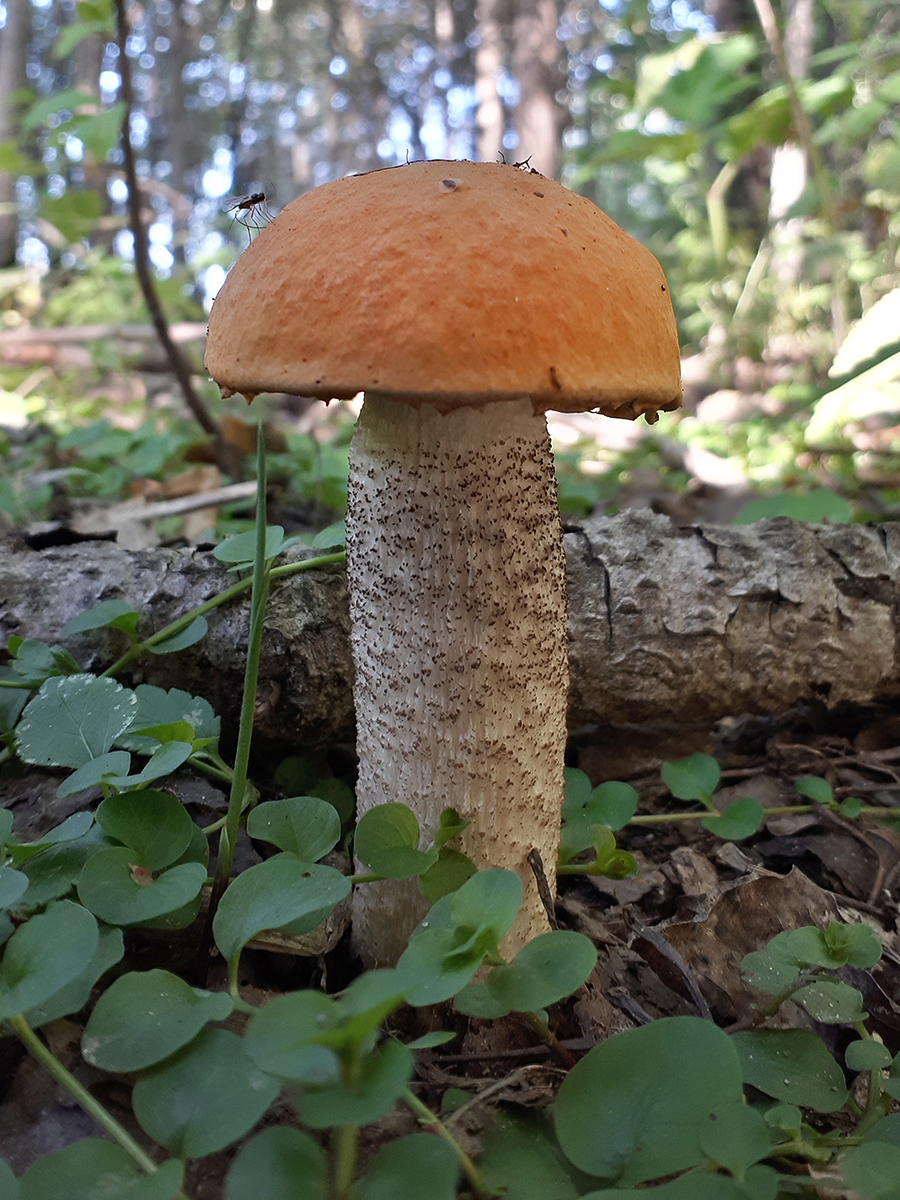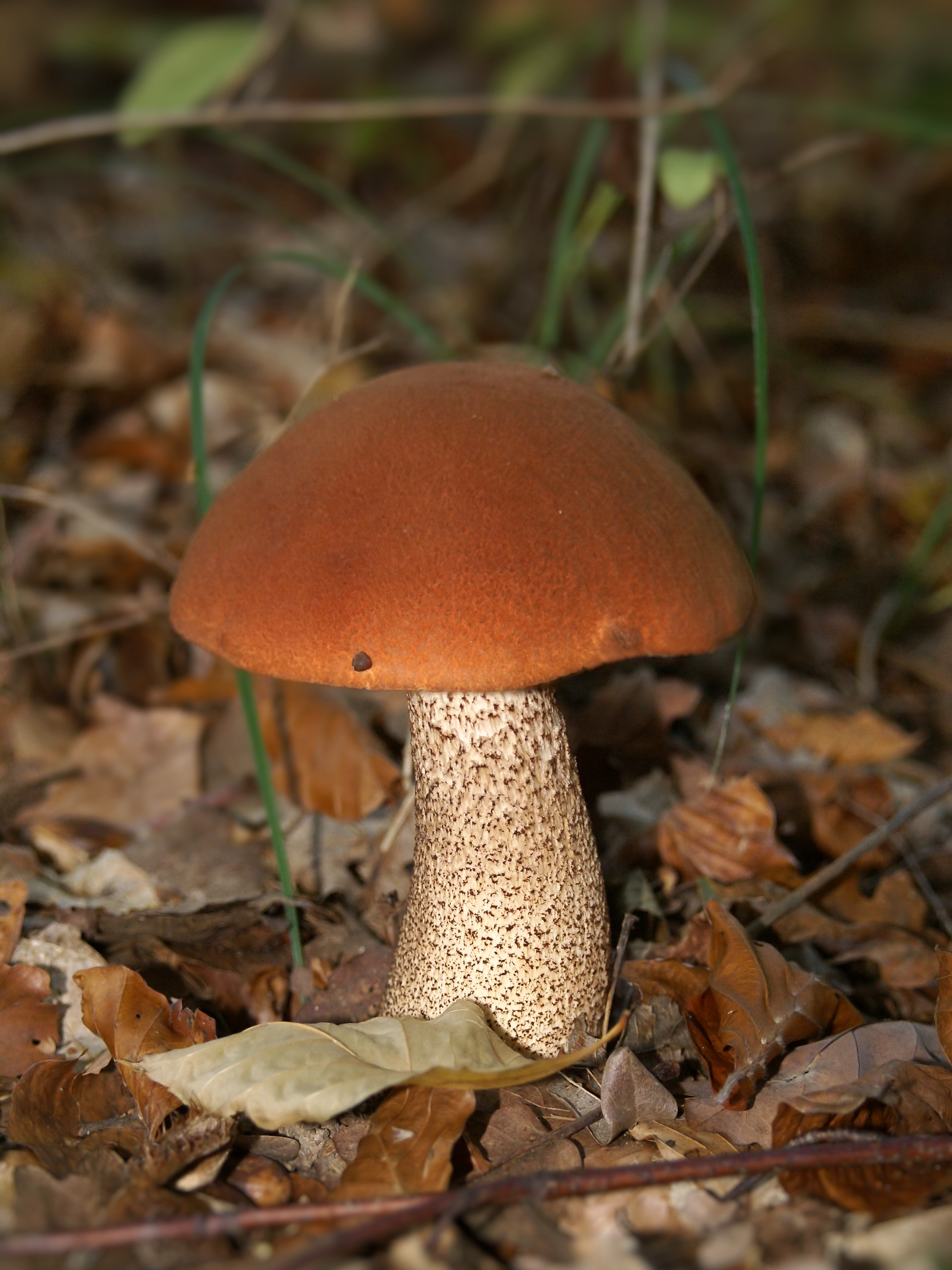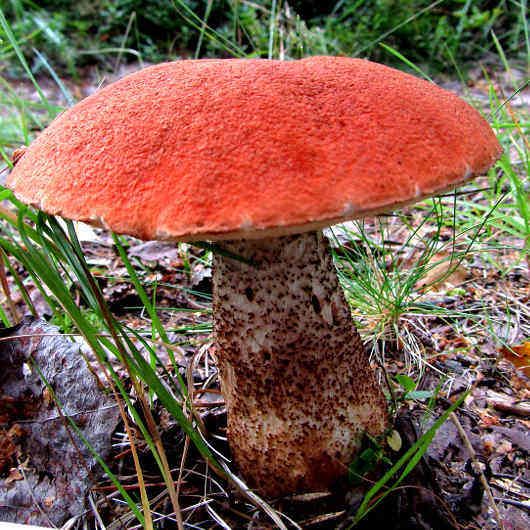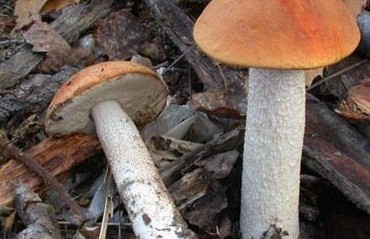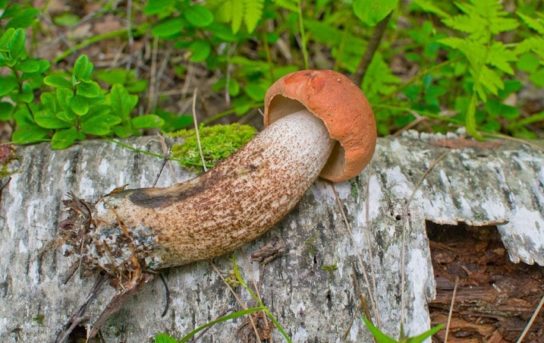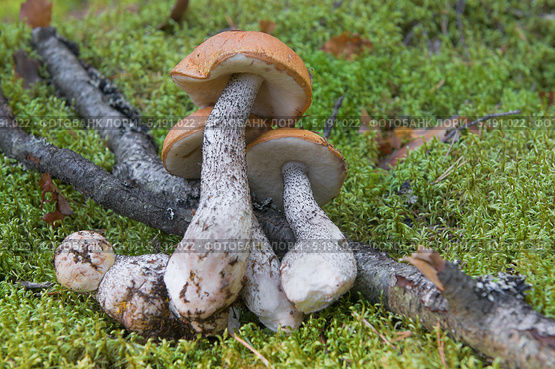Time and place of fruiting
Boletus will not grow unless with coniferous tree species. He loves all the rest (deciduous) and gets along well with them. However, the most frequent guest is at aspens, poplars and sometimes under willows. It can form mycorrhiza with beech, oak, birch and hornbeam.
Young trees in deciduous forests are a favorite place of the red beetle, it is often found in small forests and aspen thickets. Fruiting occurs in small groups, often singly. It grows in clearings, along forest roads, in the grass.
You can meet them in all the forests of Eurasia, in the tundra, the European part of Russia, in the Caucasus, the Far East, as well as in the Urals and Western Siberia. The varieties that grow in North America are classified as other species.
You can harvest all summer until November. They bear fruit three times, respectively, they have special names. Those mushrooms that appear in June are called Spikelets. July mushrooms grow more abundantly and are named Stubble mushrooms. But the most widespread are Deciduous, which are found from August and later.
Description of red boletus
The diameter of the cap varies from 4 to 15 centimeters, the diameter of especially large specimens can reach 30 centimeters. The shape changes as it grows from hemispherical with firmly pressed edges to cushion. The color of the cap is red, brown-red, orange. The skin is smooth, but sometimes it can be velvety. It does not come off the hat.
The color of the cap varies depending on the place where the mushroom grows. In poplar forests, gray-colored boletuses are found, and mushrooms with dark red caps grow in aspen forests. In mixed forests, boletuses with yellow-red and orange caps can be found.
The flesh in the cap is dense, fleshy, with age it becomes much softer. In the stem, the pulp is fibrous. The color of the pulp when cut is white, but quickly turns blue, and then, in general, turns black. The pulp does not have a special taste and smell.

The cap is easily detached from the stem. The tubular layer is free, white, over time, its color changes to brown-yellow, yellowish or olive. Spores are smooth, fusiform. The length of the tubes ranges from 1 to 3 centimeters. The pores of the tubular layer are angularly rounded, small. If you touch the porous surface, it darkens.
The leg length ranges from 5 to 15 centimeters, and the thickness is 1.5-5 centimeters. The leg becomes wider towards the base. The color of the leg is grayish-white. Its surface with longitudinal fibrous scales is white; as the fungus ages, the scales acquire a brown tint. Spore powder of olive brown color. Spores are smooth, fusiform.

Growing places of red boletus
These boletuses grow in mixed and deciduous forests. You can find them under young trees. For mycorrhiza, red aspen boletuses choose deciduous trees, and conifers are excluded, most often aspen and poplar are preferred. In more rare cases, red boletuses form unions with oak, willow, hornbeam, beech and birch.
Krasnyuks bear fruit in small groups. These mushrooms choose different places to grow: forest roads, glades, lawns. They are common in the North-Western and European parts of our country, in the Urals, the Far East, Siberia and the Caucasus.
Red boletuses are numerous in wooded areas of Eurasia, where they grow in the tundra under dwarf birches.

The fruiting season of the red boletus falls in June-October. The most fertile places are aspen groves and small forests. During dry periods, these mushrooms hide in damp aspen shoots.The peak yield of "spikelets" is observed in late June - early July, "stubble" is harvested from mid-July, and the third harvest of "deciduous" is the longest and most massive, these mushrooms are harvested from mid-August to September.
Edibility of the red beetle
The red boletus is an edible mushroom. It can be boiled, marinated, dried and salted. In terms of taste, red aspen mushrooms are slightly inferior to porcini mushrooms.
Redheads can be fried, boiled, marinated, and stewed. During processing, these mushrooms darken. To prevent darkening of the fruit bodies, they must be soaked before cooking in citric acid. When red boletuses are pickled, their color remains unchanged.

Twin mushrooms
Some mushroom lovers are afraid of poisoning with false boletus. Others generally doubt that false boletuses are in reality. Which one is right? Such a species does not really exist. All boletus "twins" are edible and pose no health hazard. Let's see how this mushroom differs from each of them.
Collecting aspen mushrooms is not difficult, because they grow in "families" and, having seen one, you can collect, if you're lucky, a whole "cart" at once. You need to cut off at the base so as not to damage the mycelium. You should not take only old mushrooms, as they will have time to deteriorate before the mushroom picker brings them home.
Some housewives have a question about what to do with blue mushrooms that differ from the boletus they saw in the photographs? After collecting the boletus, you need to immediately process and cook! If the mushrooms have lain for more than two days, even in the refrigerator, such specimens can only be thrown away. If you plan to cook them for salting, pickling or frying, they must be washed first, then cleaned and removed from possible worm damage, and then boiled in two waters. For drying, do not wash, but be sure to clean, best of all with a brush. Small fruiting bodies are well marinated or salted, strongly grown - preferably fried, stewed or dried. Mushrooms have excellent taste, go well with other products, in particular potatoes, buckwheat and rice. Good in soups and salads. You can "roll" mushroom caviar.
Boletus in the forest
Boletus yellow-brown
It is considered the largest of the boletus boletus. In some adult specimens, the size of the cap reaches thirty centimeters in diameter! He has a yellow-brown hemispherical cap and a white leg covered with black-brown scales. This mushroom grows in mixed forests, where birch and spruce prevail in addition to aspens. Stony, sandy or peaty soil is more favorable for it. A distinctive feature of this boletus is that it has a dense, white flesh at the break turns pink, and then becomes purple. The yellow-brown boletus appears in June and grows until October.
Boletus yellow-brown
Boletus red
Most often grows in aspen forests from June to October. It has a red or brownish-red cap with white, dense flesh, which becomes purple at the break, and later almost black. The leg of the mushroom is white with almost the same scales.
Boletus red
Boletus white
It is found in mixed forests where birch, aspen, and pine grow. It appears in late summer and autumn. This mushroom has a white cap and the same white stem. At the break, the flesh turns pink, and later becomes black-brown.
Boletus white
Boletus oak
possesses a velvety red-brick cap. It grows in mixed forests dominated by aspen and oak trees. All boletus boletuses love forest edges, glades, damp places. Aspen mushrooms grow in shady places, hiding under fern leaves. Aspen mushrooms grow very quickly, but just as quickly and deteriorate. Therefore, they collect young mushrooms, which are called brisket. In young boletus boletuses, the cap looks like a thimble, which is put on a finger. Old aspen mushrooms, even if they are not wormy, are bypassed, since they may start to deteriorate while still in the basket.
Boletus oak
Moreover, mushrooms strongly absorb harmful substances, especially radioactive ones, both from the soil and from the air.
Views
As already mentioned, it is almost impossible to distinguish the types of boletus by taste. But it is worth knowing them, so as not to hesitate when collecting - take the found mushroom, or leave it to be eaten by the forest dwellers.
Red
This mushroom is completely edible. In symbiosis, it intertwines with the root system of aspen and other various trees: willow, birch, as well as oak, etc. It grows large - up to 15 or even 30 cm in diameter. The leg reaches 5 cm thick, and it can even be as high as 15 cm in height. The color of the cap is usually red, bright red or brownish. On the leg there are scales of a grayish hue, which darkens over time. The flesh of the red boletus darkens on the cut. You can meet this representative in almost all parts of the country. It usually grows near young aspens, often found along forest paths, ditches. You can start hunting for such a mushroom from June and continue until September.
Yellow-brown
This type of boletus is also called red-brown or mixed-skinned boletus. Its peculiarity is the creation of mycorrhiza with birches. You should look for such mushrooms in forests, where most of all birches, aspens and spruce, sometimes grow in pine groves. They like to settle in forest belts, most often found in areas with moderate climatic conditions.
The cap grows on average up to 15 cm, the leg - up to 22. The support is covered with scales, which change brown to black with age. The hat has a light orange tint, sandy, sometimes yellow and brown. The skin on top is dry, often hanging from the edges of the cap. The pulp is light, but on the cut it begins to turn pink, and then turn blue, even acquiring a purple hue.
White
This variety is a real rarity. The fungus is listed in the Red Book, it is not easy to find it. It grows in coniferous forests, but if there are birches in them. If the weather is dry, it grows between the aspens. Loves wet areas. The white hat turns gray with age, even acquires a brown tint. It grows up to 25 cm. The dense pulp turns blue, and over time it even turns black on the cut. The creamy leg grows tall, the scales on it are also light.
Redhead or oak obabok
It is very similar to an ordinary boletus, but it likes to grow near oak trees. The cap grows up to 15 cm, the leg reaches the same height, and its thickness is from 1.5 to 3 cm. The color of the cap is brown, but with a noticeable orange tint. The scales on the support are reddish brown.
Boletus mushroom spruce and yellow-brown: description and photo
Look at the boletus mushroom in the photo, which demonstrate the richness of shades and colors:

Boletus mushroom in the photo
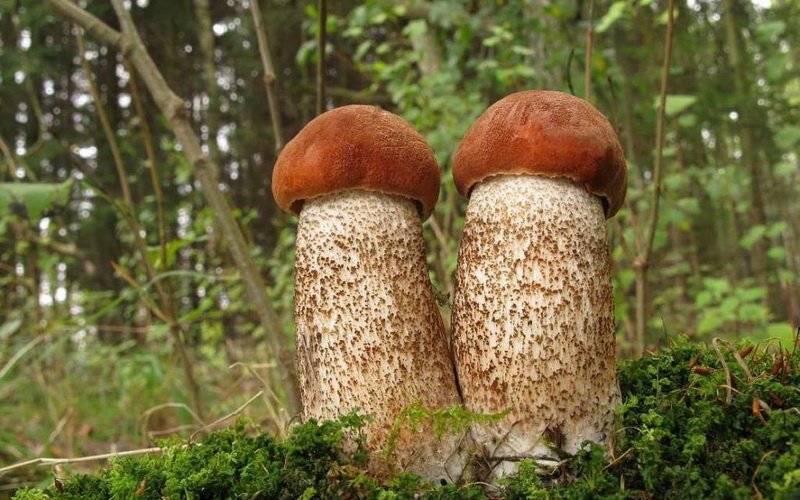
Boletus mushroom in the photo
To begin a description of the spruce boletus mushroom, it is worth starting with the fact that this mushroom is edible and has excellent nutritional value. The cap is 6-15 cm in diameter, hemispherical, then convex, fleshy. The surface of the cap is fine-fibred, matte dark brown, brown, light brown. The skin is not removable. The tubular layer is first white, then beige; the pores in the tubes are dark gray. Leg 7-15 cm long, 2-4 cm thick, fleshy white, covered with black scales. The pulp is dense white, later pinkish, at the break it becomes violet-gray or violet-black, on the cut it turns into purple-pink, and then gray-violet.
Look at the boletus mushroom in the photo and in the description, this information will allow you to accurately identify it in the forest:
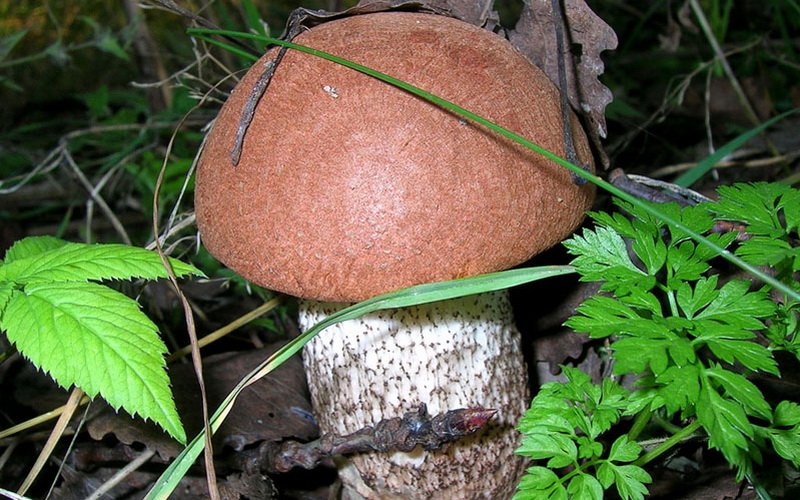
Boletus mushroom in the photo

Boletus mushroom in the photo
Large yields of spruce boletus are harvested in deciduous, mixed and pine forests.
Occurs from July to October.
The spruce boletus has no poisonous and inedible counterparts.
Due to its dense pulp, spruce boletus is the best edible mushroom. The fungus is rarely wormy.

Boletus yellow-brown in the photo
Boletus yellow-brown is edible.The cap is up to 6-15 cm, red, at first - hemispherical, then cushion-shaped, later convex, fleshy, fine-fibrous, matte, wet in the rain, but not slimy. The skin is not removable. The tubular layer is first white, then light gray-brown. Leg 7-15 cm long, 2-4 cm thick, fleshy white, covered with brown scales. The pulp is dense white, on the cut it turns into a rusty red-brown color.
Grows in coniferous and mixed forests. There is a lot of it on the banks of the Volga.
Occurs from July to October.
The blood-red boletus has no poisonous and inedible counterparts.
The dense flesh of the yellow-brown boletus makes it the best mushroom for cooking roasts, it fries a little and does not stick to the pan. Pickled boletuses are delicious and beautiful. Boletus are rarely wormy.
A brief description of the edible mushroom
Boletus or White aspen is ranked among the genus Leccinum, the Bolet family. It bears the Latin name Leccinum percandidum, there are also several synonyms - Boletus percandidus, Leccinum aurantiacum, Boletus versipellis and Krombholzia rufescens.
The cap grows up to 15 cm in diameter, less often reaches 25 cm. It has a cushion shape, white with a pink tint, brown or blue-green. Acquires yellow tones with aging. The skin is dry, naked, tomentose.
The hymenophore or the lower part of the cap consists of finely porous tubes, white or yellow, older specimens acquire a gray or brownish color. Spores are brown, buffy.
The pulp is white, rather dense, blue-green closer to the base of the leg. On the cut, it quickly becomes blue, then black, acquires a lilac color.
The leg is high, can reach 15 cm, and no more than 4 cm in diameter, its shape thickens downwards and resembles a mace. The color is white, covered with scales that eventually turn gray or brownish and have a fibrous structure.
This is such a rare guest in the basket of a mushroom picker that it is listed in the Red Book of Russia, as well as most of the regional where it grows. Forbidden to collect.
A bit of history
The first to talk about the white aspen was the Soviet scientist, mycologist Boris Pavlovich Vasilkov, who studied mushrooms in the Arctic and other regions. Scottish colleague Roy Watling helped with systematization in 1960.
Evaluation of taste, medicinal properties, benefits and possible harm
This mushroom is often compared with white and put it, if not at the level, then in second place in terms of taste. You can eat it in any form: boiled and fried, dried and salted, as well as pickled, many of these fruits are frozen.
When cooked, it becomes dark, but the color can be preserved by pickling the mushroom. Also, soaking in a 0.5% citric acid solution will make the red boletus retain its original shade. Some mushroom pickers remove the stem because of its harsh pulp.
Boletus boletuses contain a large amount of vitamins A, C, PP and B, as well as potassium, phosphorus and iron. Recommended for use in food after surgery, as well as during inflammatory and infectious diseases.

Pine Boletus (Leccinum vulpinum)
Hat:
The pine boletus has a red-brown cap, a characteristic unnatural "dark crimson" color, which is especially evident in adult mushrooms. In young specimens, the cap is worn flush on the leg; it naturally opens with age, acquiring a hammered cushion shape. As with the base model, the size of the hat can be very large, 8-15 cm in diameter (in a good year, you can find a hat and larger). The skin is velvety, dry. Dense white pulp without a special smell and taste on the cut quickly turns blue, then blackens. A characteristic feature - like the oak variety of the aspen (Leccinum quercinum), the flesh can darken in places without waiting for the cut.
Spore-bearing layer:
In youth, it is white, then grayish-cream, when pressed, it turns red.
Spore powder:
Yellow-brown.
Leg:
Up to 15 cm long, up to 5 cm in diameter, solid, cylindrical, thickened towards the bottom, white, sometimes greenish at the base, deeply sinking into the ground, covered with longitudinal fibrous brown scales, making it velvety to the touch.
Spreading:
Pine boletus occurs from June to early October in coniferous and mixed forests, forming mycorrhiza strictly with pine. It bears fruit especially abundantly (and looks spectacular) in mosses. There are very different information about the prevalence of this type of information: someone claims that Leccinum vulpinum is much less common than red boletus (Leccinum aurantiacum), someone, on the contrary, believes that there are quite a lot of pine boletuses in season too, just when collection is not always distinguished from the basic variety.
Similar species:
There is no consensus on whether it is worth considering Leccinum vulpinum (as well as the oak (Leccinum quercinum) and spruce (Leccinum peccinum), which are inextricably linked with it), a separate species, or are they still subspecies of the red aspen (Leccinum aurantiacum). So, we will consider it as more interesting: we will arrange the pine redhead as a separate species.In fact, the characteristic red-brown (apolitical) color, brown scales on the leg, dark gray spots, than a satisfactory set of characteristics for describing a species, and many fungi do not have this either.
Edible: Yeah, I guess.
Remarks Boletus has become a rare prey in our trampled lands. And to find a rare boletus, such as pine, is a doubly joyful event. Handsome, eh?
And here's what else is interesting. Everyone knows: as soon as you touch the boletus, it immediately changes color. And this no longer surprises anyone. But if, say, a boletus is eaten by some snail or other representative of the forest fauna, a mushroom, nothing will happen. Bitten on the leg, and what? As she was white, she remained. I cannot explain this.
Boletus species
Most types of boletus are edible and tasty, but there are also false boletus. But to make mushroom hunting more interesting, study the differences and individual properties of their varieties.
Boletus red
This edible mushroom is distinguished by the fact that it does not choose a certain type of tree as a mycorrhizal partner, but is "friends" with a variety of deciduous giants: oak, beech, poplar, aspen, birch, willow. Red boletus can be described as follows:
- The diameter of the cap ranges from 4 to 15 cm, in some cases it reaches 30 cm.
- The height of the leg can be up to 15 cm, its thickness is from 1.5 to 5 cm.
- The color of the cap is bright red, red-brown, red. The skin is firmly attached to the pulp, smooth or slightly velvety to the touch.
- The outer layer of the leg is covered with gray-white scales, which, as the mushroom matures, acquire a brown tint.
If you cut the red boletus, at this point the color will change first to blue, then black. A group or a single mushroom can be found in deciduous or mixed forests. He especially loves young growth of aspen, various ditches and forest paths. The red boletus grows throughout the Eurasian territory, in the tundra it chooses places under dwarf birches. In our vast homeland, it can be seen everywhere - from the European part to the Far East, including the Caucasus. You can harvest the red boletus during the harvest season: from June to October.
Boletus yellow-brown
It is an edible mushroom that is in symbiosis with birches. Low-lying forest belts with a predominance of aspen and birch are chosen as a place of growth; they can be found in spruce-birch forests, pine forests. They grow in temperate areas. Description:
- The diameter of the cap is from 5 to 15 cm, sometimes 25 cm.
- The leg is high, reaching 8-22 cm, its thickness is about 2-4 cm.
- The hat is sandy-orange or yellowish-brown.
- In young mushrooms, the dry skin of the cap often hangs over the edge.
- The leg has a white or grayish tint, covered with granular brown scales, blackening as it grows.
Usually grows singly.If the leg is cut off, at this point it will turn pink, then blue, after which it will acquire a purple hue, sometimes green. This type of mushroom is collected all summer long. But sometimes they are met at the end of November.
Pine redhead
Belongs to edible mushrooms. He has a reddish-brown hat with a dark crimson shade, which distinguishes him from his fellows. Grows near pine and bearberry. Description:
- The diameter of a dry velvety cap reaches 15 cm.
- The length of the leg grows up to 15 cm, its thickness reaches 5 cm. Small, brownish scales are located on the leg of the redhead.
At the cut site, the flesh turns blue, then turns black. This species is less common than the red boletus. Grows in humid coniferous forests in the temperate latitudes of Europe.
Spruce redhead
It is an edible mushroom. It can be described as follows.
- The hat has a deep brown-chestnut color, hangs slightly from the edge, its diameter is from 3 to 10 cm.
- The leg in the form of a cylinder has light brown scales on the surface, slightly expanding towards the base. The length reaches 8-14 cm, the thickness is 1.5-3 cm.
The flesh of the redhead is dense, white, it becomes dark on the cut. Spruce boletus are grouped in coniferous forests, as a rule, under spruce trees, they are found in oak forests, mixed forests. The harvest season begins in July and lasts until October.
Black-scale boletus
This edible mushroom has a reddish orange, dark reddish or brick red cap. In a young mushroom, it is semicircular, dry, slightly velvety. Over time, it acquires a cushion shape, becomes smooth, reaches from 4 to 12 cm in diameter. Reddish scales are located on a 13-18 cm high leg. The flesh is firm, white; when cut, it turns purple or gray-black.
So, we learned that the boletus mushroom is edible. It owes its name to aspen, since it is closely connected with its roots, and the hat resembles an autumn leaf in color. And each species has its own characteristics and differences from others.
How to distinguish between different types of boletus
Red boletus
The red boletus (Leccinum aurantiacum), which grows mainly under the aspen and birch, is considered to be the classic representative of the boletus. This species has a very expressive appearance. In particular, a noticeable (though not poisonous-bright) red-orange or brick-colored hat. And also a leg covered with white or grayish scales.
Redhead oak
The boletus, or redhead, oak (Leccinum quercinum), which forms mycorrhiza with oak and grows in the corresponding forests, looks no less representative. Its velvety red-brick (closer to brown) cap sits on a leg covered with soft brown scales.
Black-scaly boletus mushroom
A similar appearance, but with darker, almost black, scales on the leg, is also characteristic of the black-scaly boletus (Leccinum atrostipiatum). However, this mushroom is much less common and, as a rule, is mistaken for a similar species of boletus.
Yellow-brown boletus mushroom
Yellow-brown boletus (Leccinum versipelle) differs from the listed species in a brighter cap color (from yellow-gray to light orange). And also those that prefers moist soil of mixed spruce-birch (birch-aspen) forests. There he often grows next to ferns. In damp places, only in the vicinity of spruce and much less often, there is also a boletus, or redhead, spruce (Leccinum piceinum) with an orange-brown cap.
Less common types
Pine redhead (Leccinum vulpinum), white boletus (Leccinum percandidum) and colored-footed boletus (Tylopilus chromapes) are uncharacteristic for other aspen mushrooms. The first has a cap of an “unnatural” dark crimson color, which is especially pronounced in adult mushrooms, and a “velvety” leg densely covered with brown scales.
It grows in coniferous forests, especially on mosses. Pine boletus is considered a rather rare species, but mushroom pickers claim that its fruiting depends largely on suitable weather conditions.The white boletus (Leccinum percandidum) is characterized by a completely "incredible" white color of the cap and leg for the boletus, which does not change with age. This species can be found more often in deciduous and mixed forests in the north, in Siberia and in the tundra. By the way, it usually grows in the neighborhood of dwarf birches.
Typical signs of these mushrooms
Some mushroom pickers, by the way, argue that the surface of the cap of this boletus in wet weather becomes sticky to the touch, and that it has a snow-white color only in the shade. And in more illuminated places it can take on a grayish or pinkish tint. Colored-legged boletus, oddly enough, for its typical appearance is also referred to as boletus. But he is not included in the Obabok genus. A distinctive feature of this mushroom is the color of the leg - a white-pink tint in its upper part smoothly turns into an expressive ocher-yellow at the base. The caps of young colored-legged boletus boletuses have the usual convex shape, but in adult specimens they are slightly flattened, and are colored, albeit dark, but nevertheless closer to pink, in color.
A typical property of most boletus boletus is the color change on the cut. Initially white, it turns slightly pink, then takes on a gray or purple hue. Black spots also appear on the sponge and on the legs from touch. A completely different picture is observed on the cut of colored-legged and pine boletus. The white flesh of the former does not change color at all. But at the base of the leg it has a distinct buffy-yellow spot. And in the second, the color of the cap on the break also does not change, the spongy layer turns red from pressure. In this case, the leg is colored at the base in olive, and closer to the center - in a red tint.

